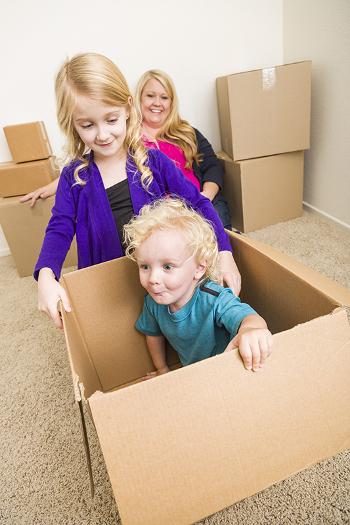A big cardboard box
Duration/age

What can you do with a big cardboard box?
Next time you have a large cardboard box give it to your child to play with. Encourage them to use their imagination.
I wonder what this big box could be. What does it look like to you?
Turn a box on its side with the opening facing out. If you add a cushion or rug you’ll have a cosy nook just right for reading or dreaming.
A large shallow box can be a road with a car park. Encourage your child to draw a road inside the box. Draw some car parking spaces nearby. Line up your child’s toy cars and go.
How many car parks can you fit along the edge of the box? Let’s measure your cars so the car parks are the right size.
A very big box - like one a fridge comes packed in - could be made into a cubby house. Use a pair of scissors or a sharp knife to cut out windows and doors. Talk with your child about the size and placement of the windows and doorway.
How many windows does your house need? Where should we put the door? How tall does it need to be?
Give your child some crayons or paint and the box becomes a giant canvas. They can colour the box inside and out.
Materials you will need
- Paint
- Crayons
- Rug
- Scissors
- Knife
- Cushions
- A big cardboard box
- Toy cars
Alternative tools
- Small cardboard boxes
Skills this activity improves
Why does this matter?
When your child is playing with a cardboard box they will be using their imagination and creativity. As they think of possible ways to use the box they will be visualising it as all sorts of things, like a car, a house or a train.
Thinking about what they can use to make wheels, a roof, or a steering wheel will help them develop skills in planning.
When your child is planning out their car parks and other designs they are developing fine motor skills.
As they size up the car parks and doors they will be learning how to measure.
What does this lead to?
Being imaginative and thinking creatively are part of being a good problem solver. Being able to solve problems or think of alternative solutions are everyday life skills.
Visualisation is another thinking skill. When children visualise they are building mental pictures. Visualisation is used to plan and to solve problems, and when reading.
Having good fine motor skills will help children with writing and manipulating small objects.
Language to use
- Box, cardboard
- Big, huge, large, enormous
- Side, corner, top, bottom
- Inside, outside, edge
- Car, train, house, boat
- Think, wonder, idea, plan
Questions to use
- Can you fit in that box?
- What could you use for wheels?
- Does your house need a roof?
- Can your brother fit in there too? What about me?
Useful tips
- You might also like to take a look at the Building a car activity.
- For safety information visit www.parenting.sa.gov.au
- Remember to talk to your child in your home language.
Variation by age
Three to five year olds
- Make a special magic cave. Turn a big box on its side. Have your child help you make small holes all over the top of the box. Carefully put a bulb from a string of fairy lights through each hole from the top. Plug in the lights and watch the magic. Remember to turn them off when you’re done.
Questions to ask
- What will happen when we turn on the lights?
- What would you like to put in the cave?


